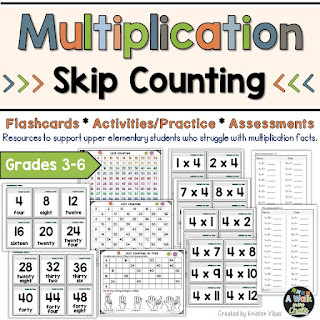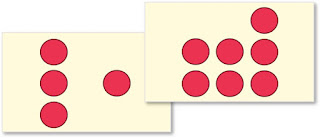It’s sometimes necessary to fill in gaps WHILE teaching grade level math content. I often have 5th and 6th grade English learners with interrupted or inconsistent schooling who come to us several years below grade level, yet who are expected to learn the grade level math curriculum.
They dive into the content, which is already fast paced, learning skills that they don’t yet have the foundation to support, all the WHILE learning a new language. That can be overwhelming, to say the least! So how can we support English learners in math AND close gaps?
For me, it’s been about finding age appropriate activities that build both number sense skills and language! Here are four activities I’ve implemented with my older ELs in order to fill in some gaps!
Number of the Day
A warm-up or math station activity that builds multiple skills around one special number. This activity is easy to differentiate and is also a good tool for building math vocabulary. There are lots of resources out there, just be respectful of your students’ ages. If you give a 6th grader a kindergarten looking activity, you’ve lost before you’ve begun.
I really appreciate that the author of this resource, Greg from Mr. Elementary Math, provided an option in this packet that does not include the grade levels written on the pages. When I come across activities that have grade levels written on them, I typically white-out that information.
I print each grade level page on colored cardstock because it’s an easy way for me to visually keep track of who is working on which activity. kinder- yellow, 1st grade- green and 2nd/3rd grade blue. I also slide them into plastic sleeves so students can use a dry erase marker, then easily wipe off for the next use.
I initially do the activity with them with heavy support, but once they learn the routine it becomes an independent activity, which is fantastic! When I have students at different levels, I simply give them the level that best meets their needs.
Number Talks
This is also a great use of 5-10 minutes to build number sense. There are lots of great videos on YouTube, if you’re unfamiliar with Number Talks. The main idea is to have students use mental math to solve a problem, then elicit conversations about the different methods students used to solve. It’s a great activity for visualizing how to manipulate numbers quickly, and showing that there are multiple ways to solve a math problem.
My 5th and 6th grade students often need support in learning their multiplication facts. I give a pre-assessment on Mondays for each times table. If they score high enough, they are done for the week. If not, I create activities and centers for those students who need practice with that times table. On Friday they take a post assessment. I put a big sand timer on the interactive whiteboard and they record their time when they finish. It’s always a lot of excitement when it comes time for the sand timer:)
I choose to focus on skip counting because it’s repeated addition, and they need practice with that skill as well.
One of the ways I build English skills during this time is I print out skip counting cards that have both the number and the number word. We sit around the table, I pass out the cards in order, then we go around the circle skip counting. To keep it exciting, we speed up each round, then after a few rounds, we pass our cards to the person to our right and do a few more rounds.
My students love this game. It teaches them the skill of skip counting to support their multiplication practice AND it builds their English language skills with number words. This is always a student favorite.
Subitizing
This is another mental math activity that uses images on cards, usually dots. Students see ways to group numbers so as to make quick mental math calculations instead of counting every dot. I found some cards online and printed and laminated them. There are lots of free resources available; you’ll be able to find free printable and video resources by searching “subitizing cards.”
I’ve used the first or last 5 minutes of class to pull out some cards and ask students questions about what they see. The cards I have also have different shapes and colors (squares, triangle, tally marks) so we can also build basic English vocabulary around those terms. It’s another fun activity my students enjoy.
Math Workshop Model
Lastly, I have to put in a big plug for the math workshop model. This model allows for a whole group mini-lesson on a grade level lesson, small group work to practice newly taught skills, differentiated station activities that are designed to meet the needs of the class (remediation, spiral review, enrichment) and a reflection or formative assessment (exit ticket). This model also allows for opportunities to add remedial activities that build number sense.
When I push-in during math workshop, I am a station for my students. We work on remediation and building math language. The classroom teacher also pulls my students into a small group, so that they get an opportunity to practice the new grade level skill in a small group setting with her. The workshop model works really well for fitting in some needed time to remediate and build number sense skills with our older ELs.
RECAP: 4 activities to build number sense with older ELs
1- Differentiated Number of the Day
2- Number Talks
3- Skip Counting/Multiplication
4- Subitizing
I’ve linked a couple of resource below that are staples in my math instruction.
Happy teaching!










